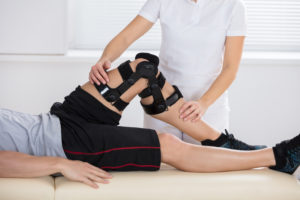 When you’ve been injured in a car accident, it is important to follow through with your recommended treatment so you can fully recover. One part of the recovery and healing process might be seeing a physical therapist for your injuries. Treatment for whiplash and other car accident injuries should be a comprehensive treatment approach so you can trust your medical team is not only addressing your pain symptoms, but also addressing the root cause of the injury and setting you up for a full recovery.
When you’ve been injured in a car accident, it is important to follow through with your recommended treatment so you can fully recover. One part of the recovery and healing process might be seeing a physical therapist for your injuries. Treatment for whiplash and other car accident injuries should be a comprehensive treatment approach so you can trust your medical team is not only addressing your pain symptoms, but also addressing the root cause of the injury and setting you up for a full recovery.
Whiplash is one of the most common car accident injuries and can vary in its severity depending on a number of factors including the force of the accident and any previous injuries that could be aggravated by the injury. When you see a physical therapist as part of your treatment for whiplash, you might be wondering how long you will need physical therapy. The length of treatment will depend on your whiplash diagnosis and treatment plan determined by your team of doctors, including your physical therapist.
What Is Whiplash?
Whiplash is an injury that occurs when the force of the accident causes your head to strongly jostle forward and backward. In the event of a car accident, the unexpected force of impact can cause the muscles and tendons in your neck to stretch out of their normal range of motion and they may even tear. This type of neck strain injury will often affect not only your neck but also your back and shoulders.
Symptoms of Whiplash
The tricky thing about whiplash is that you might not know you have this injury right away. Whiplash is sometimes called a hidden injury or a delayed injury because the symptoms can start to appear slowly in the hours and even days after the accident. Immediately after an accident, your adrenaline is pumping and you might be in a bit of shock. Both of these reactions can mask symptoms at first. Common symptoms of whiplash include head and neck pain, stiffness, dizziness, and a decrease in range of motion in your neck.
Seeking Treatment after a Car Accident
If you’ve been in a car accident, it is important to seek medical treatment immediately so a doctor can help identify any injuries and begin your treatment right away. The sooner you begin your treatment the sooner you will begin to experience relief and get on the road to healing. Your doctor will likely run a series of high-tech diagnostic imaging tests such as X-rays and CT scans in order to get a better picture of where damage has occurred. Treatment for whiplash will depend on the severity of your injury and your symptoms. Your doctor may recommend physical therapy in order to help support your recovery process.
Physical Therapy for Whiplash Treatment
Physical therapy is helpful in treatment for whiplash because of how much an injury to your neck can affect the rest of your body and your ability to complete daily tasks like normal. A physical therapist will work with you to help strengthen the muscles that support your neck and back and to help improve your flexibility and range of motion. The following are some physical therapy techniques you might experience in physical therapy treatment for whiplash.
Hot and Cold Therapies
Alternating hot and cold on an area where an injury has occurred helps to soothe the pain and reduce the swelling. Heat applied to your neck, back, and shoulders after a whiplash injury helps to encourage blood circulation, which helps bring oxygen to your sore and injured muscles and helps them relax. Applying cold to your injured body does the opposite of heat: it actually slows your circulation. Cold therapy is beneficial when you have any swelling or inflammation, and can also help relieve pain and calm muscle spasms.
Exercises and Stretches
Physical therapists use a combination of stretches and exercises to help loosen up your muscles while also building up strength and encouraging flexibility. Because whiplash affects your neck and back, your physical therapist will also focus on your posture and how you carry yourself. Going through stretches and exercises as part of your treatment for whiplash will help you recover from the injury and also help set you up to help avoid future injuries.